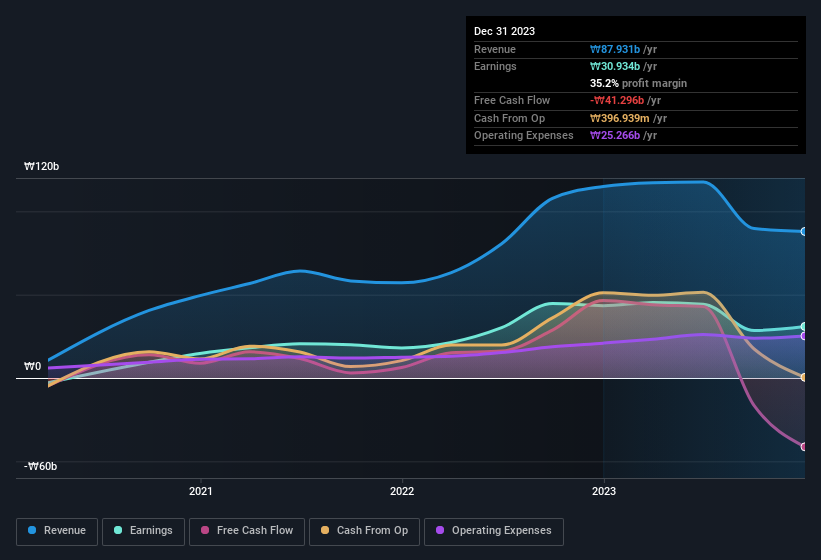- South Korea
- /
- Semiconductors
- /
- KOSDAQ:A348210
NEXTIN's (KOSDAQ:348210) Weak Earnings May Only Reveal A Part Of The Whole Picture
The subdued market reaction suggests that NEXTIN, Inc.'s (KOSDAQ:348210) recent earnings didn't contain any surprises. However, we believe that investors should be aware of some underlying factors which may be of concern.
View our latest analysis for NEXTIN

Examining Cashflow Against NEXTIN's Earnings
As finance nerds would already know, the accrual ratio from cashflow is a key measure for assessing how well a company's free cash flow (FCF) matches its profit. To get the accrual ratio we first subtract FCF from profit for a period, and then divide that number by the average operating assets for the period. You could think of the accrual ratio from cashflow as the 'non-FCF profit ratio'.
That means a negative accrual ratio is a good thing, because it shows that the company is bringing in more free cash flow than its profit would suggest. That is not intended to imply we should worry about a positive accrual ratio, but it's worth noting where the accrual ratio is rather high. To quote a 2014 paper by Lewellen and Resutek, "firms with higher accruals tend to be less profitable in the future".
NEXTIN has an accrual ratio of 0.94 for the year to December 2023. Statistically speaking, that's a real negative for future earnings. To wit, the company did not generate one whit of free cashflow in that time. Over the last year it actually had negative free cash flow of ₩41b, in contrast to the aforementioned profit of ₩30.9b. We saw that FCF was ₩46b a year ago though, so NEXTIN has at least been able to generate positive FCF in the past. One positive for NEXTIN shareholders is that it's accrual ratio was significantly better last year, providing reason to believe that it may return to stronger cash conversion in the future. Shareholders should look for improved cashflow relative to profit in the current year, if that is indeed the case.
That might leave you wondering what analysts are forecasting in terms of future profitability. Luckily, you can click here to see an interactive graph depicting future profitability, based on their estimates.
Our Take On NEXTIN's Profit Performance
As we have made quite clear, we're a bit worried that NEXTIN didn't back up the last year's profit with free cashflow. For this reason, we think that NEXTIN's statutory profits may be a bad guide to its underlying earnings power, and might give investors an overly positive impression of the company. But the good news is that its EPS growth over the last three years has been very impressive. Of course, we've only just scratched the surface when it comes to analysing its earnings; one could also consider margins, forecast growth, and return on investment, among other factors. So if you'd like to dive deeper into this stock, it's crucial to consider any risks it's facing. For instance, we've identified 2 warning signs for NEXTIN (1 is significant) you should be familiar with.
Today we've zoomed in on a single data point to better understand the nature of NEXTIN's profit. But there is always more to discover if you are capable of focussing your mind on minutiae. For example, many people consider a high return on equity as an indication of favorable business economics, while others like to 'follow the money' and search out stocks that insiders are buying. While it might take a little research on your behalf, you may find this free collection of companies boasting high return on equity, or this list of stocks that insiders are buying to be useful.
Valuation is complex, but we're here to simplify it.
Discover if NEXTIN might be undervalued or overvalued with our detailed analysis, featuring fair value estimates, potential risks, dividends, insider trades, and its financial condition.
Access Free AnalysisHave feedback on this article? Concerned about the content? Get in touch with us directly. Alternatively, email editorial-team (at) simplywallst.com.
This article by Simply Wall St is general in nature. We provide commentary based on historical data and analyst forecasts only using an unbiased methodology and our articles are not intended to be financial advice. It does not constitute a recommendation to buy or sell any stock, and does not take account of your objectives, or your financial situation. We aim to bring you long-term focused analysis driven by fundamental data. Note that our analysis may not factor in the latest price-sensitive company announcements or qualitative material. Simply Wall St has no position in any stocks mentioned.
About KOSDAQ:A348210
NEXTIN
Manufactures defect inspection and metrology systems for semiconductor and display industries in South Korea.
Exceptional growth potential with flawless balance sheet.
Market Insights
Community Narratives



